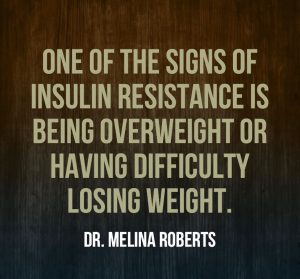Let’s talk about FIVE signs of Insulin Resistance.
I talk a lot about metabolic health and insulin resistance and some of the questions I’ve been getting is ‘how do I know if I have insulin resistance?’, ‘what are some of the signs that I have insulin resistance?’
One of the signs of insulin resistance is being overweight or having difficulty losing weight.
The receptors on your cells are not working effectively meaning that when insulin is around and goes into the receptor sites it is not easily moving glucose into the cells to make glucose useful to the body. Instead the glucose is just circulating outside of the cells and not being utilized by the cells because of that insulin resistance.
Another sign is high blood pressure. This is often a condition that people are not aware that they have. So it is getting your blood pressure checked in your doctor’s office or purchasing a blood pressure cuff to check at home and go to your local drug store and they typically have a blood pressure station. An ideal blood pressure is 120/80. If diastolic (top number) is over 140 and the systolic (lower number) is over 90, those are concerning numbers in terms of blood pressure. And one of the root causes may be an insulin resistance picture.
Another sign is that you may have early signs of diabetes. You may not be diabetic but you may exhibit some of the signs of diabetes as insulin resistance is really the pre-diabetic stage. You may feel extreme thirst and hunger, or you eat your meal and still feel hungry, frequent urination, tingling sensation in fingers and toes, tired, weakness, and fatigue.
Another way that you could test for insulin resistance is to do some blood work and look at the hemoglobin A1C test. Hemoglobin A1C will indicate what your average blood sugars are over the previous two to three months. So how well has your system been able to regulate your blood sugars. Ideally you want your AIC to be below 5.7%. If your A1C is between 5.7 to 6.4%, this is considered pre-diabetic and this is where you are typically in that insulin resistant picture. When A1C is above 6.5% that puts you in the diabetic range. Therefore that range between normal and diabetes is when you are insulin resistant and want to take control of that insulin resistance so that it doesn’t lead towards that diabetic picture.
Another way to check if you are insulin resistance is to check your fasting glucose. You can check this by doing blood work with your doctor or you can check it on your own with a glucometer. You can do a prick of the finger tip and check your blood sugar levels after fasting for at least 12 hours. Ideally we want that fasting glucose to be below 100mg/dL or below 5.6mmol/L. If your fasting glucose is between 100 and 125 mg/dL or 5.6 and 6.9 mmol/L this would be an indication that you are insulin resistant or pre-diabetic. Numbers higher than these puts you into the diabetic range.
These are indications of whether you are insulin resistant or not.



